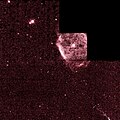| Emission nebula | |
|---|---|
| Planetary nebula | |
 PanSTARRS false-color image of NGC 40, using the red r-band image as blue | |
| Observation data: J2000 epoch | |
| Right ascension | 00h 13m 01.017s [1] |
| Declination | +72° 31′ 19.03″ [1] |
| Distance | 1,619 [2] pc |
| Apparent magnitude (V) | 11.6 [3] |
| Apparent dimensions (V) | 38″ × 35″ [3] |
| Constellation | Cepheus |
| Designations | Bow-Tie Nebula, Caldwell 2, PN G120.0+09.8 |
NGC 40 (also known as the Bow-Tie Nebula and Caldwell 2) is a planetary nebula discovered by William Herschel on November 25, 1788, and is composed of hot gas around a dying star. The star has ejected its outer layer which has left behind a small, hot star. [4] Radiation from the star causes the shed outer layer to heat to about 10,000 degrees Celsius and become visible as a planetary nebula. The nebula is about one light-year across. [4] About 30,000 years from now, scientists theorize that NGC 40 will fade away, leaving only a white dwarf star approximately the size of Earth. [4]
Contents
Morphologically, the shape of NGC 40 resembles a barrel with the long axis pointing towards the north-northeast. There are two additional pairs of lobes around the poles, which correspond to additional ejections from the star. [5]
The central star of NGC 40 has a Henry Draper Catalogue designation of HD 826. [6] It has a spectral type of [WC8], indicating a spectrum similar to that of a carbon-rich Wolf–Rayet star. [7] The central star has a bolometric luminosity of about 7,000 L☉ and radius of 0.56 R☉. The star appears to have an effective temperature of about 71,000 K , but the temperature of the source ionizing the nebula is only about 45,000 K. One proposed explanation to this contradiction is that the star was previously cooler, but has experienced a late thermal pulse which re-ignited fusion and caused its temperature to increase. [6]


